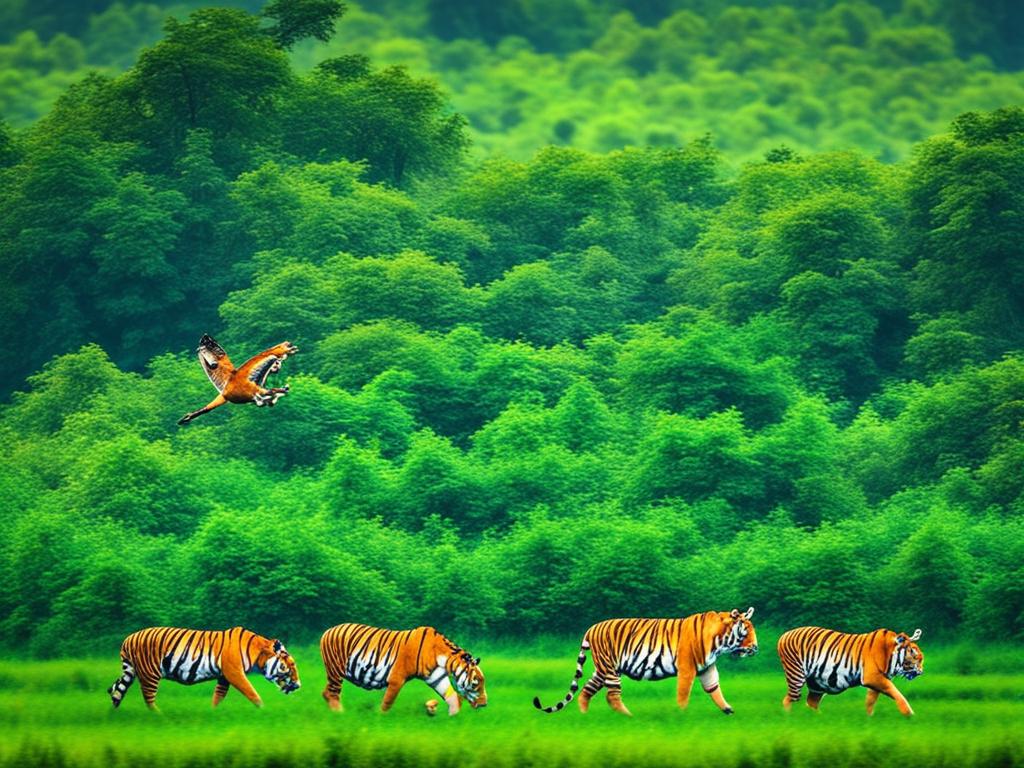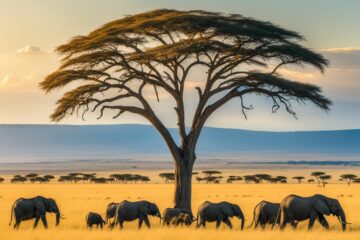As the plane started to land in Nepal, Samantha looked out the window eagerly. She had dreamed of visiting this country for years. Now, she was arriving at a place known for its beautiful landscapes. These natural wonders had always made her curious.
Her journey began in Chitwan National Park, a UNESCO World Heritage Site. The park showed off the diverse ecosystem of Nepal. As the bus moved through the grasslands and marshes, Samantha was amazed. She saw huge sal forests that provided homes for rare animals like the one-horned rhinoceros.
Walking on the dusty trails, Samantha felt something special. She felt like she was in a place where time stood still. The balance of nature was clear here. She was in Nepal, a place that stole her heart. She was excited to learn more about this magical land.
Key Takeaways
- Nepal is renowned for its diverse and captivating ecosystems.
- Chitwan National Park, a UNESCO World Heritage Site, showcases Nepal’s remarkable biodiversity.
- The park encompasses a mosaic of grasslands, marshes, and lush sal forests, providing a vital habitat for rare and endangered species.
- The one-horned rhinoceros is an iconic species found within Chitwan National Park.
- Nepal’s natural wonders have the power to capture the imagination and inspire a deep connection with the world around us.
Introduction to Nepal’s Biodiversity
Nepal’s biodiversity shows its special place in the world due to varied landscapes and climate. It’s situated between the majestic Himalayas and the Terai plains. This gives Nepal everything from snowy mountaintops to dense subtropical forests.
Geographical Location and Climate
Nepal sits in a key spot between South and East Asia. This has a big impact on the varied climate and natural beauty here. Its land goes from the towering high-altitude Himalayas to the flat lowland Terai region.
Historical Significance and Cultural Richness
Nepal’s history and culture are tightly linked to its nature. Local people have lived in harmony with the earth for ages, keeping old ways. This has helped keep Nepal’s biodiversity safe.
Himalayan Treasures: Exploring Nepal’s Mountain Ecosystems
Nepal’s mountain ecosystems, part of the stunning Himalayas, hold a vast amount of life. They are filled with a wide variety of Himalayan ecosystems and mountain ecosystems. These areas feature unique plants and animals that live in the world’s highest mountain range.
Diverse Flora and Fauna
In Nepal, the Himalayan scenery supports an incredible mix of plants and animals. The land includes towering peaks, icy valleys, and flowery meadows that are home to special life. You can find species like the Himalayan brown bear, snow leopard, and colorful wildflowers here.
Challenges and Conservation Efforts
Nepal’s mountain ecosystems are under threat from various issues. These include climate change, loss of habitat, and people moving in. Nepal is fighting to keep its mountain life safe. It has set up protected areas and is encouraging tourism that takes care of the environment. This work helps keep Nepal’s natural beauty for the future.
Lowland Wonders: The Terai Region
Nepal’s Terai region in the south is special too. It’s not just mountains there. It has a mix of grasslands and forests. Life here includes the one-horned rhino, Bengal tigers, and many migratory birds.
Unique Habitat and Wildlife
The Terai region is like a hidden gem. It’s rich with green grasslands, wetlands, and forests. You’ll find the rare one-horned rhino and the mighty Bengal tiger here.
Of course, many birds also love stopping here. They hang out in the wetlands during their travels. It’s a key spot for these migratory birds.
This area’s wide range of animals shows why the Terai region is important. It draws people from all over to see this unique world.
Chitwan National Park: A Jewel in Nepal’s Crown
Chitwan National Park is a UNESCO World Heritage Site. It is a gem in Nepal’s collection, highlighting the country’s beauty. This park is in the Terai region. It features grasslands, marshes, and sal forests. It’s home to many rare and endangered animals.
Diverse Landscapes and Attractions
Chitwan National Park dazzles visitors with its varied landscapes. Tall grasslands hide the one-horned rhinoceros. Tranquil wetlands welcome migratory birds. The place is a delight for your senses. You can enjoy safaris, see Bengal tigers, or take a boat down the Rapti River.
Endangered Species and Conservation Initiatives
This park protects many threatened animals, like the one-horned rhinoceros and Bengal tigers. It also shelters the gharial crocodile. The park’s team guards these animals through anti-poaching and habitat projects. They also involve the local community. This way, visitors learn how important conservation is for Nepal’s nature.
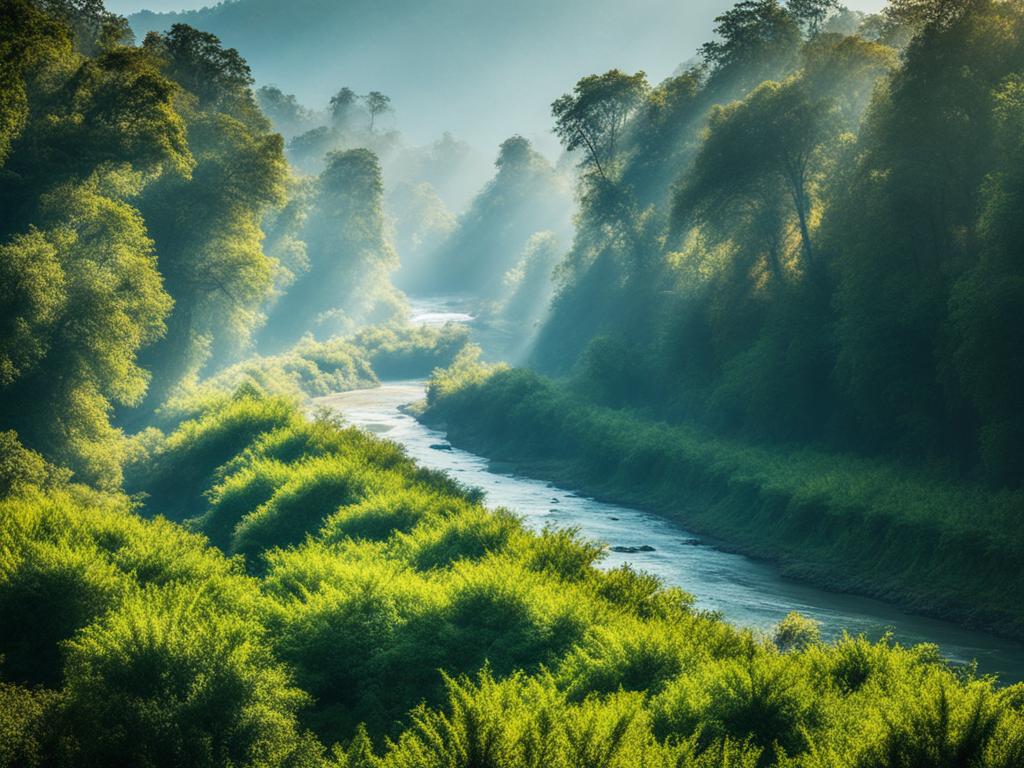
Kathmandu Valley: An Urban Oasis
Nepal is not just about its wild lands. Its cities, too, are greeneries. Kathmandu Valley stands out. This region is packed with people yet keeps its natural beauty. It has green areas and wildlife spaces among city buzz.
Blending Nature and City Life
The Kathmandu Valley shows us nature and city life can get along. It is full of old temples, stunning palaces, and lively markets. These are set against a backdrop of old trees and peaceful parks.
This mix makes Kathmandu Valley unique. For those living there or visiting, it’s an escape. It’s a break from the busy world.
Environmental Challenges and Solutions
Yet, the valley has its struggles. Too many people and factories harm the environment. This leads to bad air, little water, and few green areas.
But, the people and leaders here are working hard. They’re using smart ways to keep nature and the city in balance. They’re doing things like improving public transport and using clean energy. They’re also growing urban forests and building places that are good for the planet.
These efforts in Kathmandu Valley are a lesson. They show other cities how to grow but still care for the Earth. They’re an example for cities worldwide. It’s about how we can build our cities without harming our planet.
Trekking Adventures: Immersing in Nepal’s Wilderness
Nepal attracts many adventure-seekers with its vast wild areas. Trekking is a top draw here. The country’s mix of rugged Himalayan peaks and lush valleys provides diverse trekking adventures. This lets visitors deeply experience its natural wonders.
Popular Trekking Routes
The Annapurna Circuit is a highlight, known for its varied beauty. This treacherous path from the Annapurna Massif’s dry areas to the green Kali Gandaki Valley is awe-inspiring. The Everest Base Camp trek offers a close look at top Himalayan peaks, including Mount Everest.
For a quieter journey, the Langtang Valley and Manaslu Circuit Treks are perfect. They show off Nepal’s rugged mountains, glaciers, and quaint villages. Here, trekkers can dive into the wilderness of Nepal.
Responsible Tourism and Sustainable Practices
Trekking’s rise in Nepal shines a light on responsible tourism and sustainable practices. The aim is to preserve the environment’s fragility. Steps include using eco-friendly lodges and proper waste disposal. They also focus on protecting natural resources.
Adopting these green measures helps protect Nepal’s stunning trekking routes. It also supports the country’s wilderness and the local communities. This way, travelers play a vital role in conserving these areas.
| Popular Trekking Routes | Highlights | Difficulty Level |
|---|---|---|
| Annapurna Circuit | Diverse landscapes, Annapurna Massif, Kali Gandaki Valley | Moderate to Challenging |
| Everest Base Camp | Majestic Himalayan peaks, Mount Everest | Challenging |
| Langtang Valley Trek | Rugged mountains, glaciers, picturesque villages | Moderate |
| Manaslu Circuit Trek | Stunning mountain vistas, remote villages | Challenging |
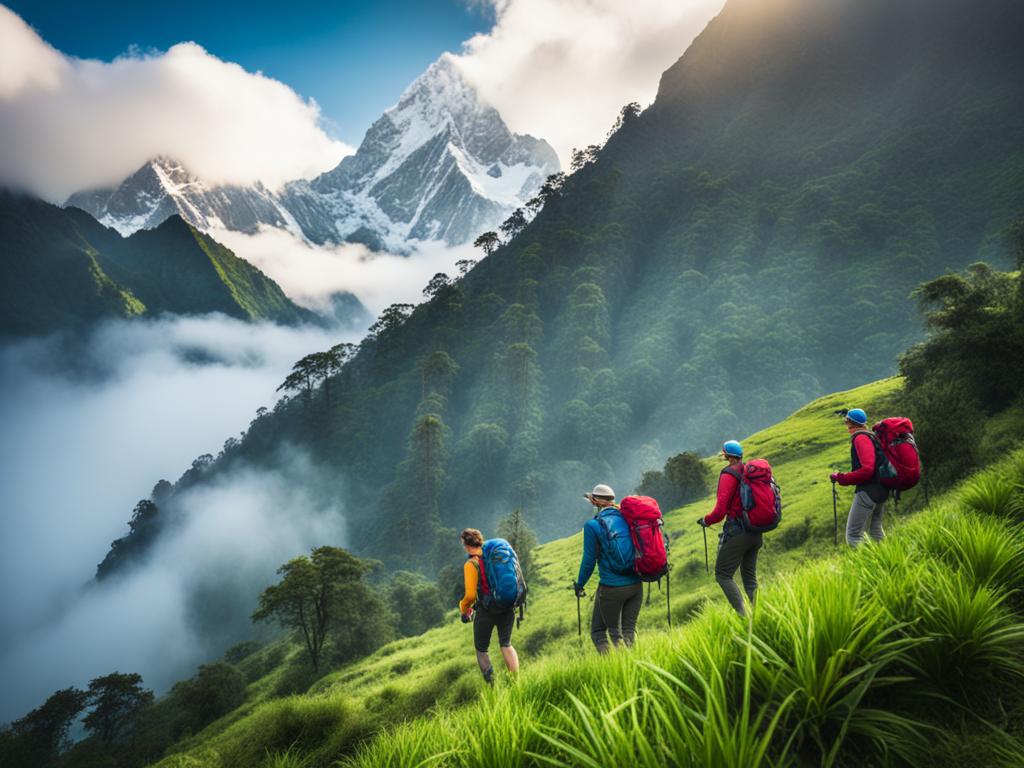
Indigenous Communities: Guardians of Nepal’s Ecosystems
Nepal’s incredible range of plant and animal life comes from its many types of land and weather. But it’s also thanks to the link between Nepal’s indigenous communities and nature. These groups have protected traditional knowledge and sustainable practices for ages. This has helped keep the land and all its resources safe.
Traditional Knowledge and Practices
Nepal’s indigenous communities know a lot about how to care for the land and its creatures. They have a special understanding of the local environment, animal behaviors, and the importance of keeping nature in balance. This wisdom has been handed down from parent to child. It teaches ways like careful gathering, fixing animal homes, and saving special spots. All these help nature thrive.
Challenges and Opportunities
The people of these indigenous communities help a lot to keep Nepal’s nature safe. Yet, they are running into some big problems. Things like fast building, everyone moving to cities, and the changes in weather are making it hard to live and protect their lands. But there are chances to turn these issues into good things for nature. The deep caring and smart ways of these indigenous communities can make better plans to save nature.
Threats to Nepal’s Biodiversity
Nepal has amazing biodiversity but faces many serious threats. These include climate change, which is already impacting its varied ecosystems. This could put their long-term survival at risk.
Climate Change and Its Impact
Global climate change is messing up the usual weather and temperatures. Nepal’s ecosystems are feeling a heavy strain. The melting Himalayan glaciers are forming dangerous lakes. On top of that, the animals’ yearly rhythms and breeding seasons are getting mixed up because of odd rain patterns.
Climate change is hitting Nepal’s already endangered plants and animals hard. They are finding it tough to keep up with the changing environment.
Habitat Loss and Fragmentation
Besides climate change, habitat loss and fragmentation are also big issues. Quick urban growth, building new structures, and turning natural areas into farms or mines have badly affected habitats.
This breakup makes it harder for animals to move and survive. It also messes with the balance of Nepal’s ecosystems.
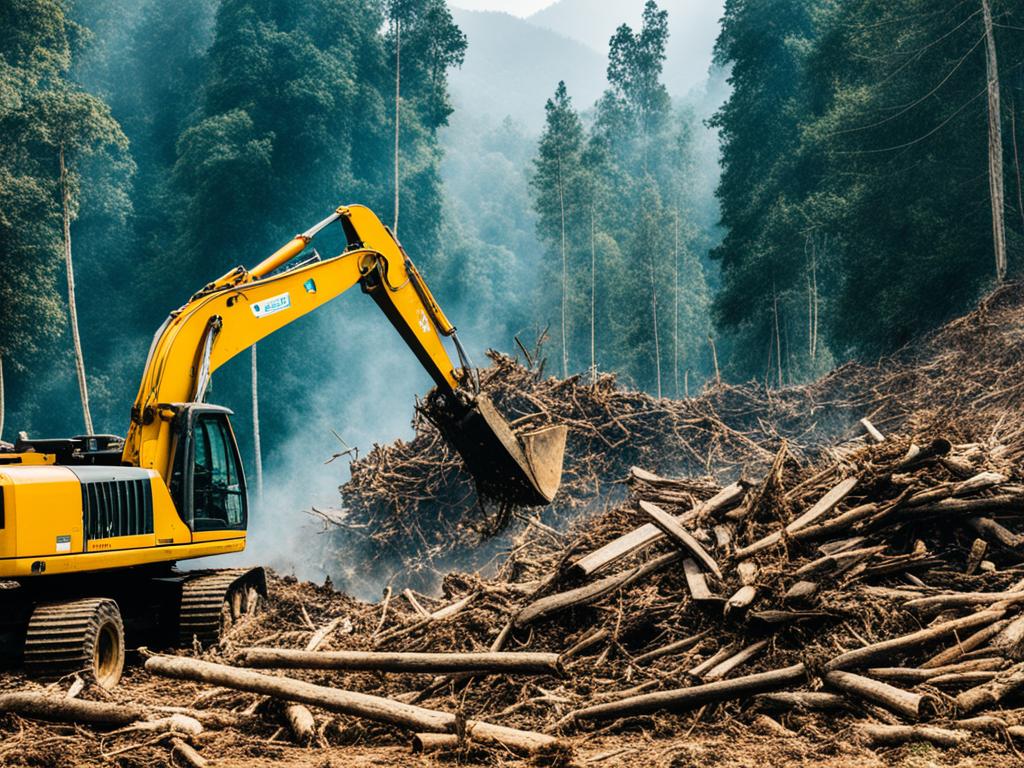
Conservation Efforts and Sustainable Tourism
Nepal faces big risks to its diverse plants and animals. Yet, the Nepalese government is working hard to save its wildlife and support progress. They’ve set up policies and projects to protect the country’s many ecosystems.
Government Initiatives and Policies
The government made safe spaces like national parks and wildlife areas. These places help save endangered animals, like the one-horned rhinoceros and the Bengal tiger. They also keep a healthy environment for all plant and animal life.
Stopping poachers is also a big goal. The government is teaming up with police and locals to stop the illegal wildlife trade. They’re also making rules to guide tourism in a way that’s good for the land.
Role of Non-Governmental Organizations
NGOs and local people are fighting for Nepal’s nature alongside the government. They train and give tools to communities to care for nature. These groups also push for better environment laws and bring in money for nature projects.
By working together, the government, NGOs, and locals are doing a great job. They use their knowledge and connections to save Nepal’s wildlife. They also help the country grow through eco-friendly tourism.
